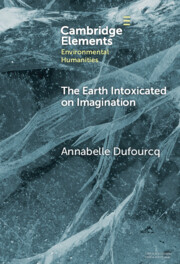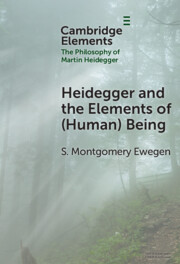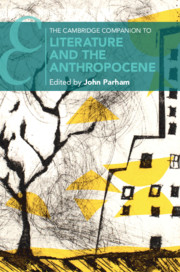Refine search
Actions for selected content:
108 results

The Earth Intoxicated on Imagination
-
- Published online:
- 31 July 2025
- Print publication:
- 28 August 2025
-
- Element
- Export citation
Chapter 3.8 - Electricity
- from Sec 3 - Physics
-
- Book:
- Dr Podcast Scripts for the Primary FRCA
- Published online:
- 19 June 2025
- Print publication:
- 03 July 2025, pp 406-416
-
- Chapter
- Export citation

Heidegger and the Elements of (Human) Being
-
- Published online:
- 17 March 2025
- Print publication:
- 17 April 2025
-
- Element
- Export citation
6 - The Barren Fig Tree (Lk 13:6–9)
-
- Book:
- Luke's Unique Parables
- Published online:
- 28 February 2025
- Print publication:
- 06 March 2025, pp 65-70
-
- Chapter
- Export citation
The Earth Is Sweet. On Cottica Ndyuka (De)compositions
-
- Journal:
- Comparative Studies in Society and History / Volume 66 / Issue 2 / April 2024
- Published online by Cambridge University Press:
- 05 February 2024, pp. 242-266
-
- Article
- Export citation
4 - Missing voices
- from Part 1
-
-
- Book:
- Young Children and the Environment
- Published online:
- 05 January 2024
- Print publication:
- 05 January 2024, pp 71-90
-
- Chapter
- Export citation
8 - Isostasy and the Terrestrial Planets
-
- Book:
- Isostasy and Flexure of the Lithosphere
- Published online:
- 28 September 2023
- Print publication:
- 02 November 2023, pp 471-522
-
- Chapter
- Export citation
IAU374: Lunar Impact Events by Sharjah Lunar Impact Observatory (SLIO) in 2020
-
- Journal:
- Proceedings of the International Astronomical Union / Volume 19 / Issue S374 / August 2023
- Published online by Cambridge University Press:
- 18 December 2025, pp. 77-86
- Print publication:
- August 2023
-
- Article
- Export citation
Jupiter and Evolution of Complex Life on Earth
-
- Journal:
- Proceedings of the International Astronomical Union / Volume 19 / Issue S374 / August 2023
- Published online by Cambridge University Press:
- 18 December 2025, pp. 97-104
- Print publication:
- August 2023
-
- Article
- Export citation
Migration of bodies to the Earth from different distances from the Sun
-
- Journal:
- Proceedings of the International Astronomical Union / Volume 19 / Issue S374 / August 2023
- Published online by Cambridge University Press:
- 18 December 2025, pp. 49-54
- Print publication:
- August 2023
-
- Article
- Export citation
Chapter 21 - Edward Thomas (1878–1917)
- from Part III - Poets
-
-
- Book:
- A History of World War One Poetry
- Published online:
- 18 January 2023
- Print publication:
- 12 January 2023, pp 350-364
-
- Chapter
- Export citation
14 - Ecological Interpretation
- from Part II - Frameworks/Stances
-
-
- Book:
- The New Cambridge Companion to Biblical Interpretation
- Published online:
- 15 October 2022
- Print publication:
- 22 December 2022, pp 265-282
-
- Chapter
- Export citation
Chapter 3: - The Structure and History of the Earth
- from Part I - Introduction to the Scientific Perspective on the Past
-
- Book:
- The Evolution of Everything
- Published online:
- 03 November 2022
- Print publication:
- 24 November 2022, pp 31-45
-
- Chapter
- Export citation
9 - On Generation and Corruption II 8
- from Part I - Introduction and Interpretative Essays
-
-
- Book:
- Aristotle: <i>On Generation and Corruption</i> Book II
- Published online:
- 10 November 2022
- Print publication:
- 24 November 2022, pp 178-191
-
- Chapter
- Export citation
16 - Venerating Earth
- from Part III - Engagements
-
-
- Book:
- The Cambridge Companion to Christianity and the Environment
- Published online:
- 21 July 2022
- Print publication:
- 04 August 2022, pp 247-262
-
- Chapter
- Export citation

The Cambridge Companion to Literature and the Anthropocene
-
- Published online:
- 28 July 2021
- Print publication:
- 17 June 2021
Postscript: A Cautionary Tale from Deep Time
-
- Book:
- Earth Detox
- Published online:
- 15 July 2021
- Print publication:
- 15 July 2021, pp 253-255
-
- Chapter
- Export citation
2 - Poisoning a Planet
-
- Book:
- Earth Detox
- Published online:
- 15 July 2021
- Print publication:
- 15 July 2021, pp 22-50
-
- Chapter
- Export citation
Chapter 1 - Earth
- from Prologue - Earth, Anthropocene, Literary Form
-
-
- Book:
- The Cambridge Companion to Literature and the Anthropocene
- Published online:
- 28 July 2021
- Print publication:
- 17 June 2021, pp 37-53
-
- Chapter
- Export citation
Popularising Croll: an opportunity for expression and creativity
-
- Journal:
- Earth and Environmental Science Transactions of The Royal Society of Edinburgh / Volume 112 / Issue 3-4 / September 2021
- Published online by Cambridge University Press:
- 24 May 2021, pp. 305-308
- Print publication:
- September 2021
-
- Article
- Export citation
